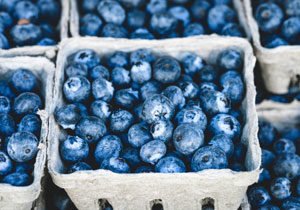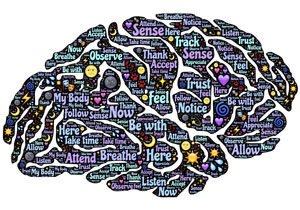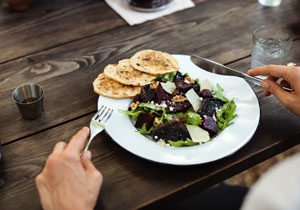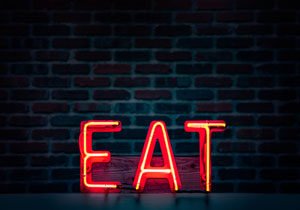 Chapter 1: What is Health?
Chapter 1: What is Health?
I discuss why it’s time to move beyond the dieting mentality, then I bust a few weight loss myths (I do love myth busting). After that, I talk a bit about Health At Every Size® (including myths about it), and about what it means to be “embodied.” I wrap up the chapter by talking about the importance of compassionate self-care.
 Chapter 2: Getting Launched
Chapter 2: Getting Launched
I start with finding motivation for change, and why it’s OK to feel ambivalent about change. Then I fill you in on setting SMART, values-based goals so you actually have a roadmap for where you want to go. Next, I talk about how the power of positivity can help “reprogram” your brain, and how mindfulness can help you form habits that stick. Then you’ll get some ideas for making changes from a mindset of self-care, not self-control. Finally, you’ll learn how thinking of what your future self would say can help you make decisions rooted in authentic self-care.
 Chapter 3: Eating for Health
Chapter 3: Eating for Health
I fill you in on why the healthiest, most nutritious way to eat may be different for you than for anyone else, as well as the benefits of loving your food (because pleasure and nutrition are perfect partners). However, the most nutritious ways of eating do have some things in common, so I discuss the benefits of “plant-forward” diets, and why they don’t mean you have to only eat plants (unless you want to). Then I talk about he difference between energy density and nutrient density, and why you want more of the second, less of the first. Finally, I go into myth-busting mode so you’ll understand why you can’t “disease-proof ” yourself.
 Chapter 4: Cooling the Fire of Inflammation
Chapter 4: Cooling the Fire of Inflammation
I explain what inflammation is, and why it’s not always a bad thing (the key is whether it’s acute inflammation or chronic inflammation). Then I give you a user-friendly explanation of the glycemic index, and why even though it can guide you to make more healthful food choices, you shouldn’t treat it as gospel. Of course, it’s impossible to talk about inflammation without talking about your gut microbiota—or the Mediterranean diet, which can be a good model for how to eat. Next I go a little deeper into the components of an anti-inflammatory diet, and why, even though healthful diets are about the sum of many parts (rather than a handful of “magic” foods), there are some foods that can rightly be called anti-inflammatory powerhouses. Do you wonder how food allergies, intolerances or sensitivities affect inflammation? I end this chapter with a quick overview.
 Chapter 5: The Power of Produce
Chapter 5: The Power of Produce
I give you the low-down on fruits and vegetables, and why they play different yet slightly overlapping roles in a healthful, nutritious diet. Confused about whether to buy organic or non-organic? I put the debate into perspective, so you can feel more confident about your shopping decisions. What about eating seasonally…does it matter? Does it limit you to eating kale and root vegetables in the winter? Let’s discuss. Now, why are vegetables and fruits so darn good for you? Vitamins? Sure. Minerals? Sure. But mostly, it’s about the phytochemicals. Then cue the orchestra, because I wrap up this chapter with a serenade to the joys of dark leafy greens.
 Chapter 6: Staying Strong
Chapter 6: Staying Strong
One part of staying strong is getting the amount of protein your body needs. I talk about how much you need and how often you need it. I also explain he power of plant proteins, whether or not you also choose to eat meat, poultry, fish, eggs or dairy. And, because I love to myth-bust, I bust a few myths about protein. The other part of staying strong? It’s exercise…and there are a million other reasons to move your body. When thinking about what types of movement to do, it’s helpful to think of fitness as a three-legged stool, because balance is everything (and I don’t just mean being able to stand on one foot). Do you have trouble fitting in exercise in a day filled with other demands on your time? I give you some tips for getting it done.
 Chapter 7: Fuel and Fiber
Chapter 7: Fuel and Fiber
What have carbs done for us lately? More than you think. Not convinced? I do some grain myth-busting and get you excited about whole grain goodness. Speaking of grains…while most people don’t need to avoid gluten (it’s true), those with celiac disease and gluten sensitivity do need to avoid or limit gluten-containing grains. OK, once you’re on board with whole grains…then what? I won’t leave you hanging…I’ll give you the basics about preparing whole grains. Then I turn the attention to sugar. There’s been a lot of harsh talk about it, and a lot of it is deserved. Still, I see a lot of confusion about natural vs. added sugar, which I will happily clear up for you. And then there’s sugar-sweetened beverages, which are perhaps the worst way to ingest sugar, so I give you some tips for kicking the SSB habit.
 Chapter 8: The Flavor Factor
Chapter 8: The Flavor Factor
In case you’re struggling to shed the vestiges of the (unfortunate) low fat era, I explain why you need fat. I’ll also clear up confusion about what types of fat are good for us, including putting saturated fat in (dietary) context and pointing out why the trans-fat ban is a double-edged sword. Are you a fan of coconut oil? I’ll talk about why it’s far from a cure for all that ails you, as some advocates would have you believe. (Health halo alert!) Just for fun, I also clear up some myths about olive oil and canola oil. Curious about what happens when otherwise healthy fats “go bad”? I tell all…including why you should treat oils with TLC. Are you nuts for nuts? Nuts offer some of the healthiest, tastiest fats around, but don’t forget that seeds also offer good nutrition in a tiny package. Are you ready to spice it up for health? I take you on a tour of the global spice pantry to give you a head start on elevating even ordinary meals.
 Chapter 9: Healthier at Home
Chapter 9: Healthier at Home
Like or not, home cooking is the key to better nutrition. I talk about the bumpy, but ultimately fulfilling road to cultivating cooking skills. Because cooking after a long day can feel hard, I explain why asking yourself “What does dinner look like?” can make it easier to answer the question “What’s for dinner,” and easier to get a meal on the table. Finally, I offer some time- and money-saving tips for smart food shopping.
 Chapter 10: Your Eating Day
Chapter 10: Your Eating Day
Did you know that while meal timing and spacing matters, there’s no one formula that works for everyone? I explain that, as well as why smart snacking can be a tool for managing hunger and fitting extra nutrition into your day…but why nibbling or grazing your way through the day isn’t an optimal way to eat. Finally, a lunch break manifesto.
 Chapter 11: Finding the Time
Chapter 11: Finding the Time
Cookie-cutter meal plans don’t work (I tell you why), but investing a little time in meal planning can pay off in spades, saving you both time and stress and supporting better nutrition. You’ll learn about that as well as why planning a “perfect” pantry will save you time when grocery shopping (and even save your bacon when you haven’t had time to grocery shop). Along those lines, I talk about how to put together meals in minutes by staying organized and why thinking you’re too busy to eat well is usually not the case…even when you are truly busy.
 Chapter 12: Intuitive and Mindful Eating
Chapter 12: Intuitive and Mindful Eating
Do you know what attuned eating is? I explain that, and how to tell if your eating needs a tune-up. Then you’ll hear about the benefits of reclaiming intuitive eating instead of continuing to subscribe to external “rules” about how to eat. I also cover the basics of mindful eating, including the value of asking yourself what are you hungry for. You’ll learn some simple tips for getting started with mindful eating and get some advice for how to identify hunger if you’ve fallen out of touch with those natural cues. Did you know that eating mindlessly can affect your digestion? I talk about that, before discussing “normal eaters,” and why this rare and wonderful group is worth joining.
 Chapter 13: The Journey Ahead
Chapter 13: The Journey Ahead
I discuss how to overcome obstacles that might get in the way of your efforts to form new habits, especially the seven internal obstacles to success. Think it’s bad luck to prepare for setbacks? I explain why that sort of planning is smart, not fatalistic. Are there food pushers in your life? I share with you how to deal with these (usually) well-meaning souls gracefully so you can respect your personal food boundaries. Because social connection is important for health, I spend some time outlining why dining out and socializing doesn’t mean that you can’t eat for both nutrition and pleasure. Finally, I offer up some tips for staying on track towards your health and nutrition goals.
 Chapter 14: Being a Savvy Nutrition Consumer
Chapter 14: Being a Savvy Nutrition Consumer
I want you to feel confident when consuming nutrition information, so I offer some solid advice to help you decide who you can trust (besides yourself) for that information. Feel like you get whiplash when reading seemingly contradictory nutrition headlines? I have specific tips to keep in mind when reading about nutrition research. I also talk about why it’s a good thing to be immune to health halos, since a lot of foods that have halos aren’t all they are cracked up to be.
 Chapter 15: Head Games
Chapter 15: Head Games
Let’s face it, stress and emotional eating are parts of life, but the good news is that you can cultivate tools to reduce their grip on you. I offer some advice on how to get better at coping with cravings, including how to figure out if it’s a true craving…or a mere impulse. I also circle back around to tips for finding and feeling hunger, especially when it’s all tangled up in your cravings. Do you feel like you’re a food addict? I explain why the notion of food addiction is controversial, and may sometimes be a self-fulfilling prophecy. Finally, I offer some clues for how to tell the difference between disordered eating and an eating disorder.
 Chapter 11: Finding the Time
Chapter 11: Finding the Time Chapter 12: Intuitive and Mindful Eating
Chapter 12: Intuitive and Mindful Eating Chapter 13: The Journey Ahead
Chapter 13: The Journey Ahead Chapter 14: Being a Savvy Nutrition Consumer
Chapter 14: Being a Savvy Nutrition Consumer Chapter 15: Head Games
Chapter 15: Head Games

